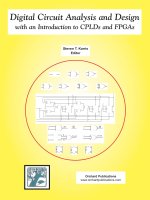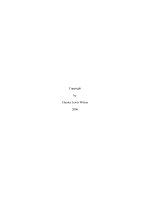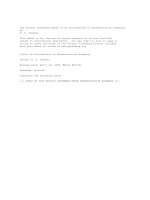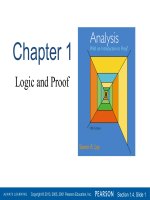Analysis with an introduction to proof 5th by steven lay ch03c
Bạn đang xem bản rút gọn của tài liệu. Xem và tải ngay bản đầy đủ của tài liệu tại đây (227.2 KB, 13 trang )
Chapter 3
The Real Numbers
Copyright © 2013, 2005, 2001 Pearson Education, Inc.
Section 3.5, Slide 1
Section 3.5
Compact Sets
Copyright © 2013, 2005, 2001 Pearson Education, Inc.
Section 3.5, Slide 2
Definition 3.5.1
A set S is said to be compact if whenever it is contained in the union of a family F
of open sets, then it is contained in the union of some finite number of the sets in F .
If F
is a family of open sets whose union contains S, then F is called an open cover
of S. If G ⊆ F
and G is also an open cover of S, then G is called a subcover of S.
Thus S is compact iff every open cover of S contains a finite subcover.
Example 3.5.2
To see this, let An = (1/n, 3) for each n ∈
(a) The interval S = (0, 2) is not compact.
•
•
•
•
•
•
(
(
(
S
(
)
A4
)
A3
)
A2
)
A1
|(
|
)|
|
0
1
2
3
{ ABut
...G, A=nk }
n1 , if
If 0 < x < 2, then by the Archimedean
property 3.3.10(c), there exists p ∈
such that 1/p <
x.
F = {An : n ∈
is any finite subfamily of F , and if
An1 ∪ L ∪ Ank = Am =
It follows that the finite subfamily G
Copyright © 2013, 2005, 2001 Pearson Education, Inc.
.
Thus x ∈ Ap and
} is an open cover for S.
m = max {n , …, nk}, then
1
( m1 , 3) .
is not an open cover of (0, 2) and (0, 2) is not compact.
Section 3.5, Slide 3
Example 3.5.2
(b) Let S = {x1, …, xn} be a finite set and let F = {Aα: α ∈ A } be any open cover of S.
Aα 2
Aα1
•
x1
Aα n
Aα 3
•
x2
•
x3
A
For each i = 1, …, n, there is a α
set
i
from F
{ A 1 ,..., Aα n }
It follows that the subfamily
α
that
F
•
xn
• • •
contains x
i
, since F
is
an open cover.
also covers S. We conclude that any finite set
is compact.
In proving a set is compact we must show that every open cover has a finite subcover.
It is not sufficient to pick a particular open cover and extract a finite subcover.
Because of this, it is often difficult to show directly that a given set satisfies the definition
of being compact. Fortunately, the classical Heine-Borel theorem gives us a much easier
characterization to use for subsets of
Copyright © 2013, 2005, 2001 Pearson Education, Inc.
.
Section 3.5, Slide 4
Lemma 3.5.4
If S is a nonempty closed bounded subset of
, then S has a maximum and a minimum.
Proof: Since S is bounded above and nonempty, m = sup S exists by the completeness axiom.
We want to show that m ∈ S.
If m is an accumulation point of S, then since S is closed,
we have m ∈ S and m = max S.
If m is not an accumulation point of S, then for some ε > 0 we have N *(m; ε) ∩ S = ∅.
(If this intersection were empty,
But m is the least upper bound of S, so N (m; ε) ∩ S ≠ ∅.
then m – ε would be an upper bound of S.) Together these imply m ∈ S, so again we
have m = max S. Similarly, inf S ∈ S, so inf S = min S. ♦
Theorem 3.5.5
The Heine-Borel Theorem
A subset S of
is compact iff S is closed and bounded.
For each n ∈
Proof: First, let us suppose that S is compact.
S ⊆
Then each I is open and
n
∞
Un =1 I n ,
, let In = (− n, n).
so {I : n ∈ N} is an open cover of S.
n
Since S is compact, there exist finitely many integers n1, …, nk such that
S ⊆ ( I n1 ∪ L ∪ I nk ) = I m ,
where m = max {n ,…, nk}.
1
Copyright © 2013, 2005, 2001 Pearson Education, Inc.
It follows that | x | < m for all x ∈ S, and S is bounded.
Section 3.5, Slide 5
Theorem 3.5.5
The Heine-Borel Theorem
A subset S of
is compact iff S is closed and bounded.
Proof: Next, we assume that S is compact and suppose that S is not closed.
For each n ∈
would exist a point p ∈ (cl S )\ S.
)
Then there
, we let U = (– ∞, p – 1/n ) ∪ ( p + 1/n, ∞).
n
U = (– ∞, p – 1/3 ) ∪ ( p + 1/3, ∞).
3
(
)
U = (– ∞, p – 1/2 ) ∪ ( p + 1/2, ∞).
2
(
U = (– ∞, p – 1 ) ∪ ( p + 1, ∞).
1
(
)
)|
[
S
p
Now each Un is an open set and we have
∞
Un =1U n
=
\{p} ⊇ S.
Thus {Un : n ∈
}
is an open cover of S.
Since S is compact, there exist n1 < n2 < … < nk in
S ⊆
k
Ui =1U n .
such that
Furthermore, the Un’s are nested. That is, Um ⊆ Un if m ≤ n.
i
S ⊆ UItnfollows
. that
k
p ∈ (cl S
But then S ∩ N ( p; 1/nk) = ∅,
contradicting our choice of
)\S and showing that S must be closed.
So far, we have shown that if S is compact, then S is closed and bounded.
Copyright © 2013, 2005, 2001 Pearson Education, Inc.
Section 3.5, Slide 6
Theorem 3.5.5
The Heine-Borel Theorem
A subset S of
is compact iff S is closed and bounded.
Proof: For the converse, we suppose that S is closed and bounded. To show that S is
For each x ∈
compact, let F be an open cover of S.
Sx = {z ∈ S : z ≤ x}
= S ∩ (–
define
∞, x]
B = {x : Sx is covered by a finite subcover of F }.
and let
Examples:
Sz = S
Sw = ∅
•
[
]
[
Sy
[
]
[
Sx
[
]
[
]
S
d
w
•
x
[
]
]
•
]
S
•
y
z
Since S is closed and bounded, Lemma 3.5.4 implies that S has a minimum, say d.
Then Sd = {d
}, and this is certainly covered by a finite subcover of F . Thus d ∈ B and
If we can show that B is not bounded above, then it will contain a
B is nonempty.
number z greater than sup S. But then Sz = S, and since z ∈ B, we can conclude that
S is compact.
Copyright © 2013, 2005, 2001 Pearson Education, Inc.
Section 3.5, Slide 7
Theorem 3.5.5
The Heine-Borel Theorem
A subset S of
is compact iff S is closed and bounded.
Proof: We have Sx = {z ∈ S : z ≤ x} and B = {x : Sx is covered by a finite subcover of F }.
Suppose that B is bounded above and let m = sup B.
We shall show that m ∈ S and
m ∉ S both lead to contradictions.
If m ∈ S, then since F
is an open cover of S, there exists F0 in F such that m ∈ F0.
F1, …, Fk
F0
)
(
[
S
•
•
•
x1
m
x2
Since F0 is open, there exists an interval [x1, x2] in F0 such that x1 <
Since
x1 < m and m = sup B, there exist F1,
…, F
S
But then F0, F1, …, Fkxcover
Copyright © 2013, 2005, 2001 Pearson Education, Inc.
2
k
in F
that
]
m < x2.
cover
S x1 .
, so that x2 ∈ B. This contradicts m = sup B.
Section 3.5, Slide 8
Theorem 3.5.5
The Heine-Borel Theorem
A subset S of
is compact iff S is closed and bounded.
Proof: We have Sx = {z ∈ S : z ≤ x} and B = {x : Sx is covered by a finite subcover of F }.
Suppose that B is not bounded above and let m = sup B.
On the other hand, if m ∉ S, then since S is closed there exists an ε > 0 such that
N
(m; ε )
∩ S = ∅.
N (m; ε )
)
(
[
S
]
•
[
S
]
m
But then Sm – ε = Sm + ε/2.
Since m – ε ∈ B, we have m + ε
/2
∈ B, which again contradicts m = sup B.
Since the possibility that B is bounded above leads to a contradiction,
we must conclude that B is not bounded above, and hence S is compact. ♦
Copyright © 2013, 2005, 2001 Pearson Education, Inc.
Section 3.5, Slide 9
In Example 3.4.15 we showed that a finite set will have no accumulation points.
We also saw that some unbounded sets (such as
) have no accumulation points.
As an application of the Heine-Borel theorem, we now derive the classical
Bolzano-Weierstrass theorem, which states that these are the only conditions
that can allow a set to have no accumulation points.
Theorem 3.5.6
The Bolzano-Weierstrass Theorem
If a bounded subset S of
at least one point in
Copyright © 2013, 2005, 2001 Pearson Education, Inc.
contains infinitely many points, then there exists
that is an accumulation point of S.
Section 3.5, Slide 10
Theorem 3.5.6
The Bolzano-Weierstrass Theorem
If a bounded subset S of
one point in
contains infinitely many points, then there exists at least
that is an accumulation point of S.
Proof: Let S be a bounded subset of
containing infinitely many points and suppose
that S has no accumulation points. Then S is closed by Theorem 3.4.17(a), so by the
Since S has no accumulation points, given
Heine-Borel Theorem 3.5.5, S is compact.
any x ∈ S, there exists a neighborhood N
(x) of x such that S ∩
N (x) = {x}.
N(x)
(
S
)
(
•
)
•x
( )
(
•
Now the family {N
)
•
(x) : x
(
)
•
(
)
•
•••
•••
∈ S} is an open cover of S, and since S is compact there exist
x1, …, x
n in S such that {N (x1), …, N (xn)} covers S.
But
S ∩ [ N ( x1 ) ∪ ×××∪ N ( xn )] = {x1, K , xn },
so S = {x1, …, xn}. This contradicts S having infinitely many points. ♦
Copyright © 2013, 2005, 2001 Pearson Education, Inc.
Section 3.5, Slide 11
Theorem 3.5.7
Let F
= {Kα : α ∈
A } be a family of compact subsets of
.
Suppose that the
intersection of any finite subfamily of F
Proof: For each α ∈ A , let Fα =
its complement Fα is open.
is nonempty. Then ∩ {Kα : α ∈ A
} ≠ ∅.
\ Kα . Since each Kα is compact, it is closed and
Choose a member K of F and suppose that no point of K
belongs to every Kα . Then every point of K belongs to some Fα . That is, the sets Fα
form an open cover ofSince
K. K is compact, there exist finitely
α1,
…, α
K ⊆ ( Fα1 ∪ ×××∪ Fα n ).
n such that
But
Fα1 ∪ ×××∪ Fα n = (
=
by
\ Kα1 ) ∪ ×××∪ (
\ Kα n )
\ ( Kα1 ∩ ×××∩ Kα n ),
K ∩ ( Kα1 ∩ ×××∩ Kα n ) = ∅,
Exercise 2.1.26(d), so
Thus some point in K belongs to each Kα , and
Copyright © 2013, 2005, 2001 Pearson Education, Inc.
many indices
a contradiction.
{Kα : α ∈ A } ≠ ∅. ♦
Section 3.5, Slide 12
Corollary 3.5.8
The Nested Intervals Theorem
Let F = {An : n ∈
} be a family of closed bounded intervals in
An +1 ⊆ An for all n ∈
∞
I
A
n =1 n
. Then
≠ ∅.
[
A1
]
[
A2
such that
]
[
A3
]
[
A4
]
•
•
•
Proof: Given any n1 <
n2 < … < nk in
Thus Theorem 3.5.7 implies that
Copyright © 2013, 2005, 2001 Pearson Education, Inc.
I
, we have
∞
A
n =1♦ n
I
k
A
i =1 ni
= Ank ≠ ∅.
≠ ∅.
Section 3.5, Slide 13









